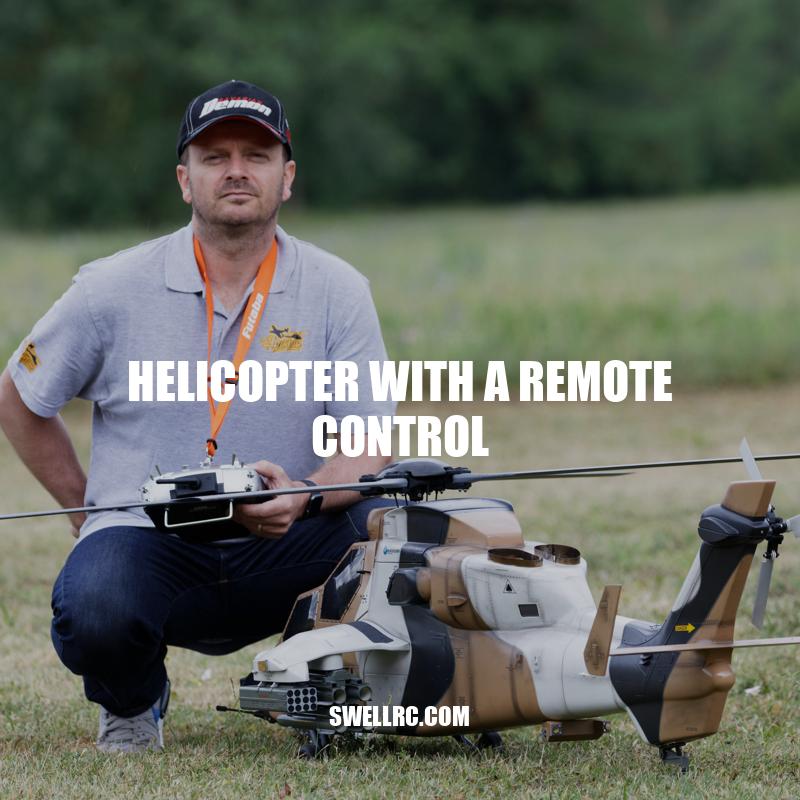Remote Control Helicopters: Everything You Need to Know
A helicopter with a remote control is a fascinating gadget loved by many enthusiasts who enjoy the thrill of flying. It is essentially a miniature helicopter that you can operate using a remote controller from a distance. While it may seem like a simple toy, it requires some skill and practice to fly smoothly. There are various types of remote control helicopters available, including toy models for children and hobby-grade models for adults. Some helicopters also feature additional accessories like cameras and LED lights, which add to the excitement of flying. In this article, we will explore all there is to know about the helicopter with a remote control. We will discuss the different types, features, and techniques needed to fly one. Whether you’re a beginner or an experienced flyer, this article will give you a comprehensive guide to get the most out of your remote control helicopter.
Types of Remote Control Helicopters
There are two primary types of remote control helicopters: toy-grade and hobby-grade. Let’s take a closer look at each type:
- Toy-grade: Designed for children aged five or older, toy-grade remote control helicopters are smaller, less expensive, and easier to operate. They are often made of plastic, which makes them more prone to breaking.
- Hobby-grade: These helicopters are for adults and more experienced users. They are often more expensive, have more features and are built from more durable materials. Hobby-grade models can generally travel faster and further than toy-grade helicopters, but they are typically harder to control.
Some popular toy-grade models include the Syma S107G and the Blade Scout CX, while popular hobby-grade models include the Blade 230S and the Align T-Rex 450L. Before purchasing a remote control helicopter, it’s essential to consider your level of experience, budget, and the features you need for your needs.
What is the best beginner remote helicopter?
The best beginner remote helicopter is the Syma S107G. It’s easy to fly, durable, and affordable. Here are some features of the Syma S107G:
- 2-channel control for easy flying
- 6-axis gyro stabilization for stability in flight
- Metal frame for durability
- USB charging for convenience
- Multiple color options to choose from
You can buy the Syma S107G on Amazon or other retail websites for under $30. It’s a great choice for anyone looking to get into remote helicopter flying.
Features of a Remote Control Helicopter
Remote control helicopters come with various features that enhance their functionality and overall flying experience. Here are some common features to look out for:
| Feature | Description |
|---|---|
| Camera | Allows you to take aerial photos and videos during flight |
| LED lights | Provides visibility during night flights and makes the helicopter more visible |
| Adjustable speed | Allows you to control the speed of the helicopter to your liking |
| Gyroscopic stabilizer | Ensures steady and smooth flying by providing stability and counteracting wind and turbulence |
| Remote control distance | Determines the distance range in which the helicopter can be operated from the ground |
| Battery life | Determines how long the helicopter can fly before needing to be recharged or have the batteries replaced |
Some high-end remote control helicopters come equipped with GPS, advanced obstacle avoidance technology, and automatic return-to-home feature. Remote control helicopters can provide a surreal flight experience for both indoor and outdoor use, making them a perfect gift for kids and kids at heart. To learn more about remote control helicopters, check out popular brands like Syma, Blade, and Holy Stone with high-end models like The Blade Nano S2, the Syma S107H, and the Holy Stone HS170 Predator.
What are the special features of helicopter?
Helicopters, also called rotary-wing aircraft, are unique flying machines that have several distinct features that set them apart from fixed-wing aircraft. Some of the special features of helicopters are:
- Vertical takeoff and landing (VTOL) capabilities, which allows them to take off and land from almost any flat surface, including in confined areas without a runway.
- Hovering ability, which enables them to stay in one place in mid-air for an extended period of time, making them ideal for tasks such as search and rescue, surveillance, and filming.
- Maneuverability, as helicopters can fly forwards, backwards, sideways, and even rotate in place, giving them a significant advantage in tight spaces or when navigating difficult terrain.
- Ability to fly at low speeds and altitudes, which makes them suitable for conducting inspections, aerial surveys, and other tasks that require closer proximity to the ground.
- Rotating main rotor blades, which generate lift and thrust, and a tail rotor or fenestron located at the back that provides stability and directional control.
- Ability to perform autorotations, which means they can safely land even in the event of an engine failure.
These features make helicopters uniquely suited for a wide range of applications, including civilian transport, law enforcement, military operations, emergency medical services, and wildfire suppression.
For anyone fascinated by helicopters, there are several websites and products available that can offer more in-depth information about their design, history, and uses. Some of these include Helicopter Museum, Helicopter Association International, and helicopter toys and models available on Amazon.
How to Fly a Remote Control Helicopter
Flying a remote control helicopter can be challenging, especially if you are a beginner. Here are some basic flying techniques and controls you need to understand to get started:
- Take-off: Gradually increase throttle to make the helicopter lift off the ground.
- Hover: Use the elevator and rudder control to stabilize the helicopter in mid-air.
- Landing: Reduce throttle to decrease altitude and gently land the helicopter on the ground.
- Throttle: Controls the speed of the helicopter.
- Rudder: Controls the direction of the helicopter.
- Elevator: Controls the vertical movement of the helicopter.
It’s important to note that different models of remote control helicopters may have slightly different controls and flying techniques. Be sure to read and understand the instruction manual before attempting to fly.
Some helpful tips for flying a remote control helicopter include:
- Practicing basic flying techniques on a calm day with little to no wind.
- Starting with a basic model and gradually progressing to more advanced models.
- Avoiding flying in crowded areas, near people, and near power lines.
- Charging the batteries before flight and ensuring they are securely in place.
- Following the safety guidelines provided in the instruction manual.
With practice and patience, you can master flying a remote control helicopter and enjoy the excitement of soaring through the skies.
How do you fly a helicopter remote?
Flying a remote-controlled helicopter requires a basic understanding of the controls and techniques for achieving lift-off, controlled flight and landing. Here are the basic steps:
- Charge the battery before use and install it in the helicopter.
- Turn on the helicopter and place it on a flat surface.
- Use the controller to adjust the throttle and lift the helicopter off the ground.
- Use the joystick or directional buttons to control the movement of the helicopter in the air.
- Practice hovering in one spot before attempting any complex maneuvers.
- Gradually learn how to control the helicopter’s movements and master different flying techniques.
It’s important to read the user manual and practice flying in a safe and open space. There are many websites, such as Horizon Hobby or Hobbytron, that offer a variety of remote-controlled helicopters for beginners and advanced users alike.
Tips for Flying a Remote Control Helicopter
To improve your flying skills and get the most out of your remote control helicopter experience, here are some tips to follow:
- Practice regularly: The more you fly, the better you will become.
- Start with a basic model: If you are a beginner, start with a simple, low-cost model that is easy to fly.
- Avoid crowded areas: Fly in a spacious, open area away from people, animals, and obstacles.
- Follow the instructions: Carefully read the instruction manual that comes with your helicopter and familiarize yourself with the controls and recommended safety guidelines.
- Check the weather: Strong winds, rain, or snow can affect the stability and safety of your helicopter. Avoid flying in these conditions.
- Tweak the settings: Most remote control helicopters come with adjustable settings for altitude, speed, and sensitivity. Experiment with these settings to find the right balance for your flying style.
- Join a community: There are online forums, social media groups, and local clubs for remote control aviation enthusiasts. Connect with others who share your passion and exchange tips and advice.
- Consider upgrading: If you have mastered flying a basic model and are looking for a more advanced or feature-packed helicopter, research and compare different models and brands before making a purchase.
By following these tips, you can fly your remote control helicopter safely and confidently, and maximize your enjoyment of this exciting hobby.
How can I get better at RC flying?
To get better at RC flying, here are a few tips:
- First and foremost, practice regularly and consistently.
- Join a local RC flying club to learn from experienced flyers, get tips and tricks, and practice flying with others.
- Use a simulator to practice flying without the risk of damaging your RC aircraft. There are various free and paid simulators available online.
- Improve your knowledge of aerodynamics and aircraft design to better understand how your aircraft handles in the air.
- Invest in quality equipment, such as a reliable radio transmitter and a well-built RC aircraft, to improve your overall flying experience.
- Watch online tutorials, read books, and attend workshops to learn new techniques and strategies for RC flying.
If you’re looking for additional resources, websites like RCGroups.com and FliteTest.com offer a wealth of information on the hobby, including reviews and forums for discussion and advice. Additionally, there are various RC flying products available to help you improve your skills, such as flight stabilization systems and training aircraft.
Maintaining a Remote Control Helicopter
Remote control helicopter is an exciting toy that requires proper maintenance to keep it functioning well. Here are some tips to help you keep your helicopter with a remote control in top condition:
- Clean after every flight: Use a soft, damp cloth to wipe down the helicopter and remove dirt, dust, and debris that can damage it.
- Avoid crashes: To prevent rotor, blade, or other part damage, fly your remote control helicopter in an open, safe area. Avoid risky maneuvers, high altitudes, and sharp turns.
- Check the battery: Ensure the battery is fully charged before flying and replace it once it starts showing signs of wear or power loss.
- Inspect the rotors: Check the rotors for cracks, bends, or imbalance. If there is an issue, replace the rotor or professional help can be sought.
- Examine the body and wires: Regularly check the body and wires of the helicopter for any signs of damage or wear. Tighten any loose screws or connections.
- Store properly: Store your remote control helicopter in a clean, cool, and dry place, away from sunlight or heat. Avoid leaving the battery inside the helicopter for too long.
Keep these maintenance tips in mind to ensure the longevity of your helicopter with a remote control, so you can keep achieving smooth flying experience.
Don’t forget to check out remote control helicopters on Amazon for a wide variety of different brands and models that suit your preferences and budget.
Are remote control helicopters hard to fly?
Flying a remote control (RC) helicopter can be challenging, especially for beginners. However, with practice, anyone can learn to fly an RC helicopter like a pro. The difficulty level largely depends on the type of helicopter, its size, and the skill level of the pilot.
Some factors to consider when learning to fly an RC helicopter are:
- The helicopter’s weight and size
- The type of controller and its features
- The wind and weather conditions
- The environment you are flying in
- The experience and skill level of the pilot
To make flying an RC helicopter easier, it is recommended to start with a beginner-friendly model and practice in a large open space free of obstacles and people.
There are many online resources available for learning to fly an RC helicopter, including instructional videos and forums. Additionally, purchasing a simulator program such as RealFlight or Phoenix can provide valuable practice without the risk of crashing your helicopter.
Overall, while RC helicopters may have a learning curve, with patience and practice, they can be a fun and rewarding hobby.
Conclusion
In conclusion, owning a helicopter with a remote control can be a thrilling experience that offers endless fun and entertainment. Whether you are a kid or an adult, a beginner or an expert, a remote control helicopter can provide a unique way to explore the skies and test your flying skills.
When choosing a remote control helicopter, make sure to consider the type, features, and size that suit your needs and preferences. Practice basic flying techniques and safety guidelines to avoid accidents and improve your skills. Maintain your helicopter regularly by cleaning, checking, and replacing any damaged or worn parts.
You can find a wide range of remote control helicopters online or in hobby stores, along with accessories, spare parts, and repair services. Some popular websites for remote control helicopter enthusiasts include HobbyKing, Horizon Hobby, and Tower Hobbies.
Overall, a helicopter with a remote control is a fantastic gadget that can bring excitement, joy, and learning opportunities to anyone who tries it. So don’t hesitate to take off and enjoy the ride!



